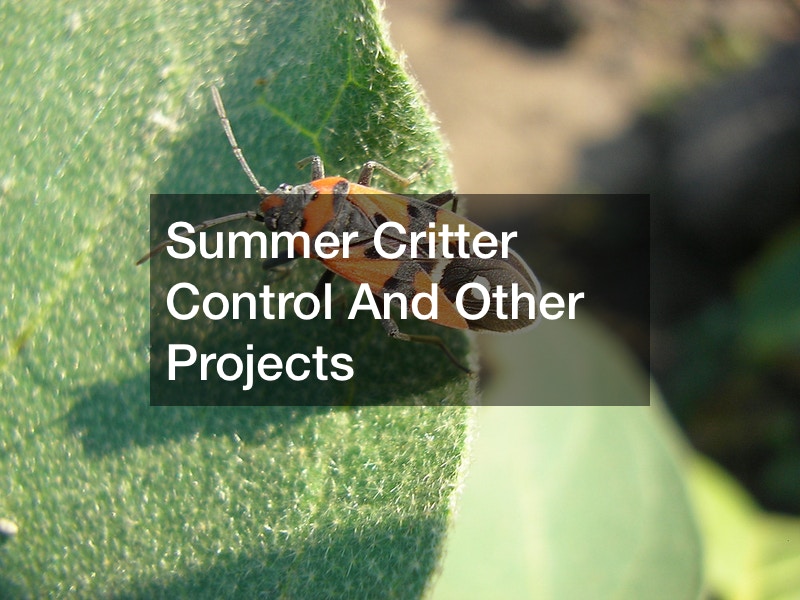
As the temperature heats up, so does the activity of pests. Why is the summertime a pests favorite season? Here are the top five reasons why cockroaches, spiders, ants, and mosquitoes appear to thrive in the warmer months.
Temperature: The rising mercury in Spring and Summer has a noticeable effect on the way common pests act and develop. But when it becomes too hot, even these pests dislike it. For example, fire ants burrow deep into the soil; while other pests seek the indoors to escape from the heat.
Moisture: Pests need water to survive; this is why they thrive in areas that are moist.
When there is moisture in the air it creates a shock. Therefore, the high humidity created by summer showers makes conditions that are favorable. When there is a drought, these pests will go inside in an effort to find moisture and damp areas.
Sources of food: the summertime is lush with vegetation. This vegetation is what feeds the pests. This is what keeps the pest population fed until their food source is gone, therefore causing the pests to move elsewhere.
Life cycle: Because most of your typical pests have cold-blood, the weather has a serious impact on their life cycle. This results in the warmer months being the time their activity increases. For example, look at how an ant colony dramatically advances in size by rapidly reproducing. This is to ensure their colony survives the upcoming colder months when they are inert.
Increased Sunlight: The warm months mean nights are short and days are increased. With an increase in daylight hours, allows pests extra time to forage for sustenance. As a result, the number of pests we see increases.
Humans are not only just annoyed by these summer pests because they are bothersome. These pests often create painful stings or bites, as well as spreading nasty illnesses. Here are a few tips to enable you to deter pests from hanging around your home and yard:
Keep gutters clean of debris; this is an ideal breeding ground for pests, as they love the moisture.
Ensure to keep all vegetation growth trimmed and not growing against the side of a building. There should be at least a two-foot barrier between your shrubbery and house. These plants give pests an easy way into your home via entry points that only they know about.
The outside perimeter of your home/building needs an inspection annually. If there are any crevices or cracks in the walls or pavement make sure you seal them with caulking.
Maintain covers that are tightly fitting on your trash receptacles. Also, if you have any dumpster, contact your waste management to ensure they rotate these out occasionally. By doing so, the conditions which encourage pest activity will be kept to a minimum. The CDC and OSHA both recommend an EPA-registered repellent for mosquitoes is used when people are working outdoors.

How to Find an Exterminator Near You
When you need to find an exterminator in your area, you need to know what pests you are dealing with. Some homeowners attempt to eliminate pests on their own; yet, it is always best to leave it to the professionals.
Refer to a directory of exterminators you find available. This ensures you find one with the tools, training and knowledge to eliminate your pest infestation.
Pest Infestation that Requires Stump Grinding Services
You had a tree cut down last winter, now the remaining stump has attracted a swarm of termites and other pests. You now have two problems. A tree stump that is rotting and a bunch of pests have taken up residence in it.
You will need to hire a tree trimming company to provide stump grinding services. The process of grinding the stump of a pest-filled tree will ensure those pests in it do not spread. In addition, a complete stump removal by grinding it will also make sure the tree doesn’t grow back.

Guarding an HVAC System from Pests
Is your HVAC unit located in an area that has a lot of plants near it? Has time caused it to become loose? If the answer to either of these questions is yes, then your HVAC system may have become susceptible to pests and insect damage.
The integrity of your HVAC system can be compromised by pests like rats and raccoons. However, the small pests, such as termites and create all kinds of damage to the home’s entire foundation. One small issue with these pests can become a giant expense.
When a pest infestation threatens our health it becomes more serious than any other infestation. Therefore, you will need to contact an HVAC company to see how to take control of these pests.
How an HVAC System is Affected by a Pest Infestation
When you have a pest infestation, there is nothing amusing about it. Aside from the fact that pests often spread a variety of allergens or severe illness, there is much more.

Affects Your Quality of Life
The ducts of your HVAC system can be the ideal way for rats or mice to maneuver through your home. If any die or leave waste the odor is then released throughout the ventilation system of your home. A very gross reality indeed! This is not only disturbing, it also offers the probability dangerous toxins and allergens are being released throughout the air system of your home. This can result in respiratory issues or even a bronchial attack.
Damage to the Unit and Property
If you have larger pests; like raccoons, rabbits or even deer, they can create more havoc to the HVAC system. They will nibble and scratch at the unit until it starts to affect your pocketbook. If the HVAC system has become home to these pests, the damage may become irreparable. The action of continuous biting, chewing and even urination, eventually forces you to do a complete replacement of the system.
Preventative Care and Pest-Proofing an HVAC System
When you want to pest-proof an HVAC system, it all begins with the outside. Exposure to a home’s atmosphere starts with the exhaust, condenser, flues and intake. These are all areas which need to be guarded against allowing pests entry. Therefore, an investment in an efficient cover is imperative. In addition to overseeing the surrounding area of the condenser to make sure there is nothing appealing to pests.
Beehive Removal Services
Bees are another summertime pest that often becomes a problem. A word of caution: Unless you are an experienced beekeeper, you should NEVER attempt to remove bees yourself!
Although honeybees may seem to be pests, they are actually critical to the environment. They play an important role in crop pollination. Therefore, you should not exterminate a flourishing colony of bees.
However, in some cases, bees become unwanted house guests. Flying in and out of your home regularly. This is when you need to enlist bee hive removal services to have the colony safely relocated elsewhere.
Before you call a bee hive removal service, ensure that the insect you have is indeed honeybees. If they are not, the beekeeper you contact will have no use for them. Other stinging insects, such as hornets, wasps, bumblebees, carpenter bees, and yellow jackets all require different approaches to pest control.
Is it a Swarm?
When relocating from the parent hive, a honey bee colony will settle on some structure outdoors. This can be playground equipment, a fence, branch or telephone pole. This will be their temporary home until they find some other chamber in which to live.
Is it a Hive?
If it is actually a hive, this is when the swarm has found its home in any hidden spaces. You are presented with a much larger issue to have it removed. The apiarist you hire to remove the beehive, make sure they are incorporated and have liability insurance coverage. This is because often the process of removal requires cutting through the siding or walls. Also, inquire with the apiarist whether you will need to hire a general contractor.
Forestry Mulching
Forestry mulching is the process of removing any remaining vegetation following a project involving the clearing of land. Instead of removing branches, fallen trees, and other vegetation after an area has been cleared, it is turned into a mulch. This is how vegetation in wooded spaces is managed. As well as restraining invasive species from spreading and refurbishing the health of wildlife.
Forestry Mulching Creates No Waste
Soil erosion was one of the significant risks posed by traditional land clearing efforts. When trees were pushed over, they uprooted roots and stumps, this was very disrupting to the earth. Mulching, by contradiction, allows the structure of the soil to remain intact. The material that results from the act of mulching then behaves as a barrier to erosion. In addition, the soil is replenished with nutrients by means of the components slowly decomposing. Eventually, there will be new growth and vegetation resulting from the mulch.
Reduces the Tick Population
Ticks are another unwelcome disease-carrying pest. They like to hitch a ride back to your house by way of your exposed skin or clothing. Forestry mulching is one way that effectively reduces the tick population. Due to an increase in illnesses, the tick carries, now more than ever is a good time to think about clearing your property. When there is an absence in vegetation and overgrown forestry, the population of ticks seems to decrease, too.
Local Site Remediation Services
Local remediation services are needed to lower radiation exposure from soil that has been contaminated, surface water, or groundwater. This is done in an effort to guard the people and the environment. Providing protection from the dangerous and potentially harmful effects of exposure to ionizing radiation.
Without local site remediation services, the local people stand to develop health effects that are undesirable. Therefore, action must be taken to remediate these lands from contamination. There are two ways this is accomplished:
By administering behaviors toward the contamination. This lease to the immobilization, removal, or isolation of the radiation’s actual source. Such as decontamination of surfaces and areas within the environmental media.
Assessing the compromises in relation to exposure to radiation. In how people think of ways to break pathways between people and the source or radiation.
These both complement one another. There are many factors at work when choosing the actual remediation efforts. There are characteristics of each site, providing no easy, fast repair.
The actions of the remediation need to be optimized and justified; endorsing actions that are more helpful than not. It doesn’t necessarily mean that an increase in radiation levels is dangerous. Some living atmospheres do have higher levels of radiation. Thereby, isolating or evacuating an area with no scientific basis may create undue stress to the people concerned.
Pest Control Efforts May be Dangerous to Pets
Luckily, the majority of techniques used by pest control professionals are safe for pets. However, you should still take a moment to discuss with the pest control technician what type of pets you have. Therefore, upon arrival, he or she knows what precautions need to be adhered to in order to protect them. Also, inquire about what you should do after they leave to ensure the safety of your pet(s).
In cases when a professional pest control company must spray chemicals for pest removal keep your household pets contained. If your pets accidentally become exposed to these chemicals they may require the assistance of a veterinarian.
Dogs can react similarly to being exposed to the pesticide as a human does. These reactions include nausea, skin rashes, vomiting, problems affecting the respiratory system, and eye irritations. Ensure to maintain your dog is a safe distance from the areas being treated for at least a long as package suggestions indicate. Usually, this means at least 2-3 hours for indoor pest control remedies; outdoors remedies about half an hour. If not, your pooch could become very ill, rendering a trip to the vet hospital for treatment.



